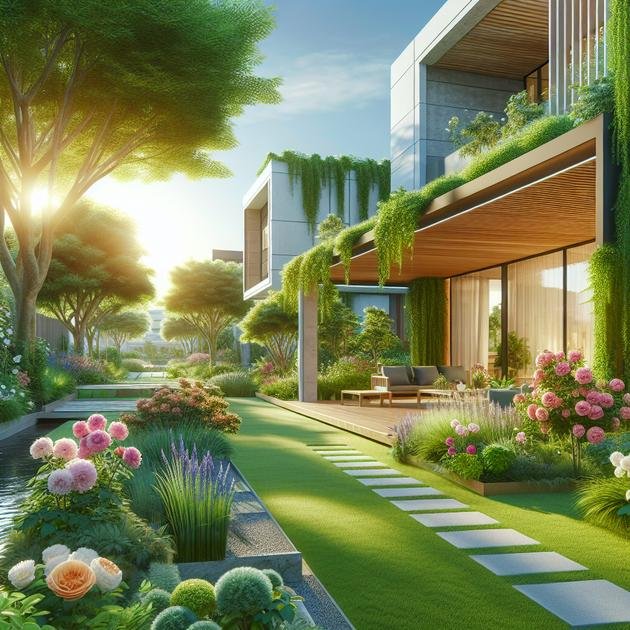Morning sun garden layout involves strategically placing plants and features to maximize gentle early sunlight, promoting healthy growth, extending growing seasons, and creating vibrant, wildlife-friendly, and inviting outdoor spaces.
If you’ve ever wondered how a morning sun garden layout can change your outdoor space, you’re in for a treat. Morning light gives plants just the right energy boost — but how do you plan around it? Let’s explore ideas that might spark your next garden refresh.
understanding morning sun and its benefits for your garden
Understanding the morning sun is key to designing a garden that thrives. The morning sun typically refers to the sunlight your garden receives during the early hours of the day, usually before noon. This light is gentler and less intense than afternoon sun, making it ideal for many plants.
Many plants benefit from morning sun because it provides essential energy for photosynthesis without the harsh heat that can cause stress. Plants like hostas, ferns, and many flowers flourish in these conditions. Additionally, morning sun can help reduce moisture on leaves, lowering the risk of disease.
Why Morning Sun Matters
Morning sun helps kickstart plant growth by delivering light during cooler temperatures, improving overall health and flowering. It also keeps your garden lively with early light that attracts pollinators like bees and butterflies, which are important for a healthy ecosystem.
When planning your garden layout, recognizing where the morning sun hits allows you to position plants accordingly. This strategy ensures that shade-loving plants are protected while sunrises-loving plants receive ample light. Overall, understanding morning sun allows gardeners to create a balanced and vibrant outdoor space.
choosing the right plants for morning sun exposure
Choosing the right plants for morning sun exposure is essential to creating a thriving garden. Plants that enjoy gentle, bright light early in the day but prefer shade in the hotter afternoons perform best here. Consider species that are naturally adapted to these conditions for healthier growth.
Ideal Plants for Morning Sun
Plants like hydrangeas, lavender, and astilbe do well in morning sun because they get enough light without overheating. Many herbs such as basil, chives, and parsley also thrive under these conditions, providing fresh flavors for your kitchen garden.
Flowering plants like tulips, daffodils, and bleeding hearts bring vibrant color and can withstand the cooler morning light. In contrast, plants that dislike harsh sun, such as ferns and hostas, also appreciate morning sun to avoid the damaging afternoon rays.
Tips for Plant Selection
Understand your garden’s microclimates by observing where morning sun hits and how long it lasts. Group plants with similar sun needs together for easier care. Choosing native species can increase success since they’re naturally suited for local light and climate.
By focusing on the right plants, you encourage robust growth and reduce maintenance efforts, helping your garden flourish in the morning light environment.
designing garden beds to maximize morning sun
Designing garden beds to maximize morning sun involves careful placement and structure to capture the most beneficial light for your plants. Begin by observing your garden in the early hours to identify which areas receive consistent morning sunlight. Use this information to position your beds where they can benefit the most.
Orientation and Layout
Orient garden beds lengthwise from east to west to expose plants evenly to the morning sun. Raised beds can help improve drainage and soil warmth, making them ideal for early sun exposure. Consider the slope of your land to ensure water doesn’t pool and that sunlight reaches all parts of the bed.
Plant Arrangement
Place taller plants or structures on the western side of the bed to avoid shading smaller plants that need more direct morning sun. Use layers by planting low-growing flowers or groundcovers in front to absorb light effectively. Spacing plants properly allows sunlight to reach lower leaves, promoting healthier growth.
Incorporate reflective surfaces nearby, such as light-colored walls or stones, to amplify the light available in your garden beds. This can enhance the effect of morning sun, especially in shaded areas.
By thoughtfully designing your garden beds, you create a thriving environment where plants get optimal light and grow robustly in the morning sun.
using container gardening effectively in morning sun spots

Using container gardening effectively in morning sun spots lets you enjoy vibrant plants in limited spaces. Containers can be moved to catch the best morning light, giving you flexibility and control over your garden.
Choosing Containers
Select containers with good drainage to prevent waterlogging. Materials like terracotta or ceramic absorb and release heat evenly, which benefits plants in morning sun. Choose sizes based on the plant’s root system to ensure enough room for growth.
Planting Tips
Fill containers with high-quality potting mix rich in nutrients. Group plants with similar water and sunlight needs together for easier care. Herbs, small flowering plants, and succulents do well in sunny morning spots and containers.
Maintenance Practices
Water containers regularly, especially as morning sun can dry soil fast. Using mulch on the surface helps retain moisture longer. Fertilize plants as needed to support growth and keep flowers vibrant.
Container gardening in morning sun spots can brighten patios, balconies, or small yards. This approach allows for creative arrangements and seasonal changes, keeping your garden fresh and lively.
combining colors and textures for a morning sun garden
Combining colors and textures in a morning sun garden creates visual interest and enhances the natural beauty of your outdoor space. Use a mix of foliage shapes, flower forms, and shades to keep your garden dynamic and appealing.
Choosing Colors
Select plants with various colors that complement each other. Warm tones like yellow, orange, and red stand out brightly in soft morning light. Cool colors such as blue, purple, and white bring a calm, soothing contrast.
Mixing Textures
Mix soft, feathery leaves with bold, broad foliage to add depth and variety. For example, pairing delicate ferns with thick-leaved hostas provides a nice tactile contrast. Flower shapes also add texture, from spiky lavender to rounded daisies.
Balance color and texture by repeating certain plants or shades throughout the garden to unify the look. This approach guides the eye and creates harmony while allowing each plant to shine in the gentle morning sun.
creating cozy seating areas bathed in morning sunlight
Creating cozy seating areas bathed in morning sunlight transforms your garden into a relaxing retreat. Choose a spot that receives gentle early light but is shielded from the harsher afternoon sun. This ensures comfort and the perfect place to enjoy the fresh morning air.
Selecting Furniture
Opt for comfortable seating options such as cushioned chairs, benches, or swings made from weather-resistant materials. Light-colored cushions reflect sunlight, adding to the brightness without absorbing too much heat.
Enhancing Comfort
Add soft throws and pillows to create an inviting atmosphere. Position umbrellas or retractable shades nearby to provide shade as the sun gets stronger later in the day.
Design Elements
Incorporate small tables for beverages or books, and use natural elements like potted plants and flower beds to frame the space. Adding wind chimes or soft lighting can make morning relaxation even more delightful.
Well-placed seating areas not only maximize the benefits of morning sun but also encourage daily outdoor enjoyment in your garden.
tips for watering and maintenance in morning sun gardens
Proper watering and maintenance are key to keeping a morning sun garden healthy and vibrant. Morning sun dries out soil more gently than afternoon sun, but regular care is still necessary to support plant growth.
Watering Tips
Water plants early in the morning before the sun gets too strong. This helps reduce evaporation and allows roots to absorb moisture effectively. Use drip irrigation or soaker hoses to deliver water directly to the soil, minimizing waste.
Soil and Mulching
Apply mulch around plants to retain soil moisture and regulate temperature. Organic mulches like bark or straw also improve soil quality as they break down.
Routine Maintenance
Check plants regularly for signs of stress or pests. Remove dead leaves and spent flowers to encourage new growth. Fertilize according to plant needs, typically once a month during the growing season.
Adjust watering schedules based on weather changes, increasing during dry spells and reducing after rain. Consistent care ensures your garden thrives under morning sun conditions.
incorporating herbs and vegetables suitable for morning sun

Incorporating herbs and vegetables suitable for morning sun into your garden boosts both beauty and utility. Many herbs and vegetables thrive with gentle, early sunlight, making them perfect for morning sun spots.
Herbs That Thrive in Morning Sun
Herbs like basil, parsley, thyme, and chives prefer morning sun combined with some afternoon shade. These plants develop robust flavors and healthy growth when exposed to soft, direct light before midday.
Vegetables Ideal for Morning Sun
Leafy greens such as lettuce, spinach, and kale do well with morning sun, as they often suffer in harsh afternoon heat. Root vegetables like carrots and radishes also benefit from cooler light conditions, which support steady growth.
Planting Tips
Group herbs and vegetables with similar sunlight and water needs together to simplify care. Use rich, well-draining soil to ensure proper nutrition and moisture retention. Rotate crops seasonally to maintain soil health and prevent pests.
By thoughtfully choosing and placing herbs and vegetables in morning sun areas, you create a productive and enjoyable garden space.
using trellises and vertical structures to catch morning sun
Using trellises and vertical structures in a morning sun garden helps maximize sunlight exposure for climbing plants while saving ground space. These structures catch early light efficiently, promoting healthy growth and adding height to your garden design.
Types of Vertical Structures
Common options include wooden or metal trellises, arbors, and pergolas. Choose materials that withstand weather and blend with your garden style. Vertical towers or wall-mounted planters also work well in smaller spaces.
Plants for Trellises
Climbing vines like morning glories, clematis, and sweet peas thrive in morning sun, showcasing vibrant flowers through the day. Vegetables such as pole beans and cucumbers use vertical supports to grow upward, improving air circulation and ease of harvest.
Placement Tips
Position trellises facing east or southeast to capture direct morning sunlight. Ensure they do not cast harsh shadows on neighboring plants. Combining vertical structures with low-growing plants at their base creates layered visual interest.
Incorporating vertical elements enhances garden space and light use, helping plants get the best benefit from morning sun.
planning pathways to enhance morning sun visibility
Planning pathways to enhance morning sun visibility improves both the functionality and beauty of your garden. Thoughtfully designed walkways guide visitors through sunlit areas, highlighting the vibrant plants and creating inviting outdoor spaces.
Pathway Placement
Place pathways so they receive maximum morning sun, typically oriented east to west. Avoid shady spots where vegetation or structures block early light. This ensures your path stays bright and welcoming.
Materials and Design
Use light-colored materials like gravel, flagstone, or pale bricks that reflect sunlight and increase brightness along the path. Curving pathways add visual interest and invite exploration, while straight lines can emphasize direction and openness.
Incorporating borders with low-growing plants or flowers that thrive in morning sun enhances the pathway’s look and feel. These borders also create a soft transition between the hardscape and garden beds.
Consider adding small seating spots or garden features along the path to encourage lingering and enjoyment of the morning light. Properly planned pathways unify your garden design while maximizing the benefits of morning sun.
integrating wildlife-friendly features in morning sun gardens
Integrating wildlife-friendly features into your morning sun garden supports local ecosystems and adds lively beauty to your outdoor space. Providing food, water, and shelter attracts birds, butterflies, and beneficial insects that help with pollination and pest control.
Planting for Wildlife
Include native flowering plants that bloom in the morning sun to provide nectar and pollen for bees and butterflies. Incorporate berry-producing shrubs and seed-bearing plants to feed birds throughout the seasons.
Water Sources
Set up shallow birdbaths or small water dishes in sunny spots to offer hydration for wildlife. Ensure water is refreshed regularly to keep it clean and prevent mosquito breeding.
Shelter and Nesting
Provide birdhouses, bee hotels, or log piles for shelter and nesting. Placing these structures in areas that receive morning sun helps keep them warm and inviting.Leaf litter and mulch also create habitats for beneficial insects and soil organisms.
Creating a wildlife-friendly morning sun garden supports biodiversity while enhancing your garden’s natural charm and vibrancy.
how to extend growing seasons with morning sun layouts

Extending growing seasons with morning sun layouts allows gardeners to enjoy fresh plants and produce for longer periods. Strategic planning and design can create microclimates that protect plants from harsh afternoon heat and cold.
Utilize Morning Sun Exposure
Position sensitive plants in areas with strong morning sunlight to warm the soil early. This boosts growth and helps young seedlings establish before warmer midday temperatures arrive.
Use Protective Structures
Incorporate features like cold frames, cloches, or row covers in spots that receive morning sun to trap heat longer into the day. These structures shield plants from frost and wind, extending their growing period.
Choose Season-Extending Plants
Select plants known for tolerating cooler temperatures and benefiting from morning sun, such as leafy greens, kale, and hardy herbs. Planting in layers with taller plants providing shade can help moderate temperature swings.
Regularly monitor soil temperature and moisture, adjusting watering and cover as needed. Thoughtful morning sun garden layouts help you enjoy your garden’s bounty well beyond typical growing seasons.
seasonal planting strategies for morning sun gardens
Seasonal planting strategies help maximize growth and beauty in your morning sun garden throughout the year. Understanding which plants thrive in each season and how morning sun impacts them is key to a healthy garden.
Spring Planting
In spring, focus on early bloomers and cool-weather crops like tulips, daffodils, lettuce, and spinach. Morning sun warms the soil gently, encouraging strong root development and vibrant flowers.
Summer Planting
Choose heat-tolerant plants that can handle increasing temperatures. Morning sun provides enough light without overexposing plants. Consider tomatoes, peppers, and herbs like basil and thyme.
Fall Planting
Plant cool-season vegetables and perennials that recover quickly after summer heat. Crops like kale, broccoli, and asters flourish with morning sun, extending your garden’s color and yield.
Winter Preparation
Prepare your garden by adding mulch and cover crops to protect soil. Choose hardy evergreens and shrubs that benefit from morning sun to maintain health during colder months.
Adapting planting schedules to seasonal changes while leveraging morning sun will keep your garden thriving year-round.
common mistakes to avoid when designing with morning sun
When designing a garden with morning sun, several common mistakes can reduce its success. Being aware of these pitfalls helps you create a more vibrant and healthy space.
Ignoring Plant Sunlight Needs
One of the biggest mistakes is planting species that require full sun in areas that only get morning sun, or vice versa. This mismatch can cause poor growth or plant stress. Always research each plant’s sunlight preferences before planting.
Poor Garden Bed Placement
Placing garden beds in shaded regions or spots with inconsistent morning sunlight limits plant development. Observe sunlight patterns throughout the day to position beds where they receive the best early light.
Overcrowding Plants
Overcrowding can prevent sunlight from reaching lower leaves, reducing photosynthesis. Ensure proper spacing to allow airflow and light penetration, which supports plant health.
Neglecting Soil Quality
Even with good morning sun, poor soil can stunt growth. Test soil regularly and amend with organic matter to provide sufficient nutrients and drainage.
Ignoring Watering Needs
Watering too much or too little can harm plants thriving in morning sun. Adjust watering based on plant type and weather conditions to avoid stress.
Avoiding these common mistakes helps ensure your morning sun garden flourishes, making the most of natural light and space.
creative lighting solutions to complement your morning sun garden
Creative lighting solutions complement your morning sun garden by extending its beauty into the evening and highlighting key features. Thoughtful lighting adds ambiance and functionality while enhancing plant colors and textures.
Types of Lighting
Use solar-powered or low-voltage LED lights to conserve energy. Spotlights and uplights accentuate focal points like trees, sculptures, or seating areas. String lights create a cozy, inviting mood perfect for social gatherings.
Placement Tips
Position lights to mimic natural shadows and avoid harsh glare. Place path lights along walkways that catch the morning sun to ensure safe navigation after dark. Layer lighting by mixing ambient, task, and accent lights for a balanced effect.
Enhancing Plants
Backlighting foliage and flowers adds depth and drama, showcasing their shapes against the night sky. Colored bulbs or filters can be used sparingly to highlight specific plants or garden zones.
Combining well-planned lighting with your morning sun garden design makes your outdoor space versatile and enchanting any time of day.
Bringing It All Together for Your Morning Sun Garden
Designing and maintaining a garden that thrives in the morning sun can be both rewarding and enjoyable. By choosing the right plants, planning carefully, and using smart lighting and layout techniques, you create a space full of life and beauty.
Remember to avoid common mistakes, support local wildlife, and extend your growing seasons with thoughtful strategies. Simple steps can transform your garden into a peaceful retreat that you can enjoy every day.
With these ideas, your morning sun garden will flourish and become a cherished place to relax and connect with nature.





